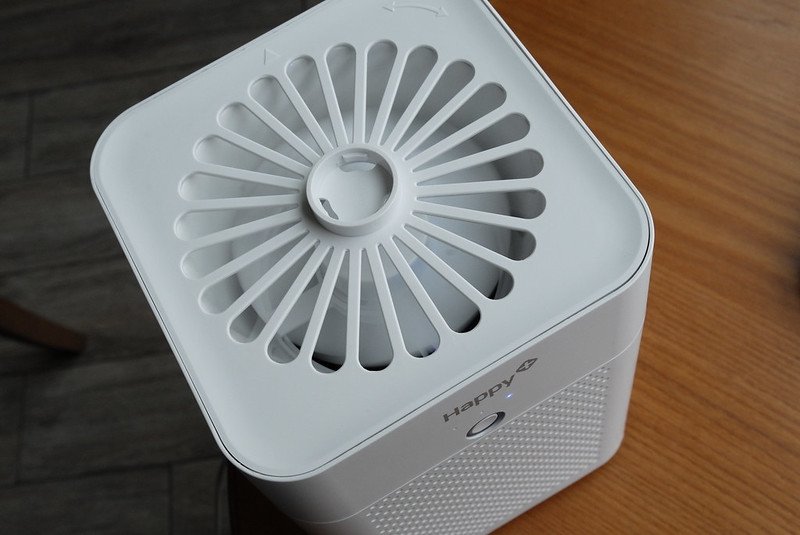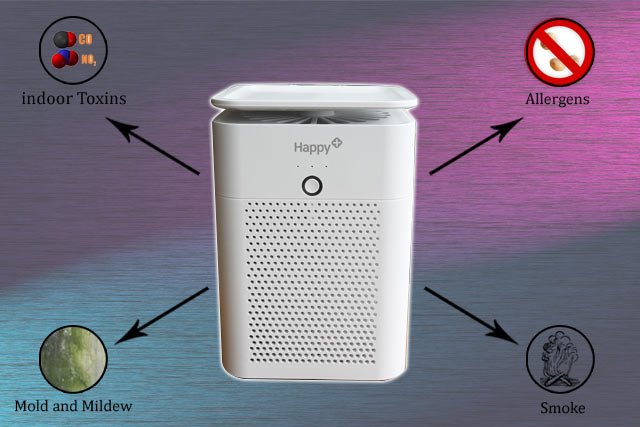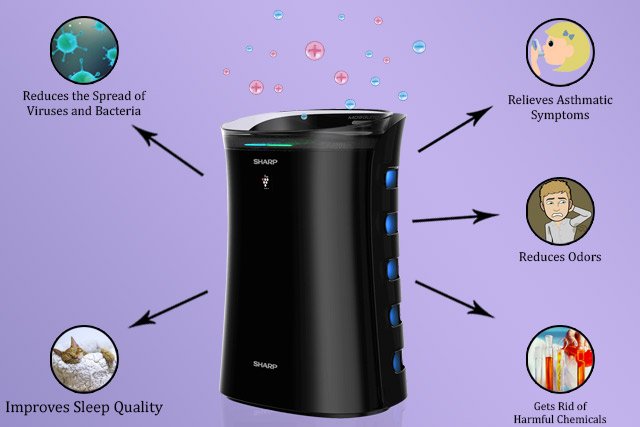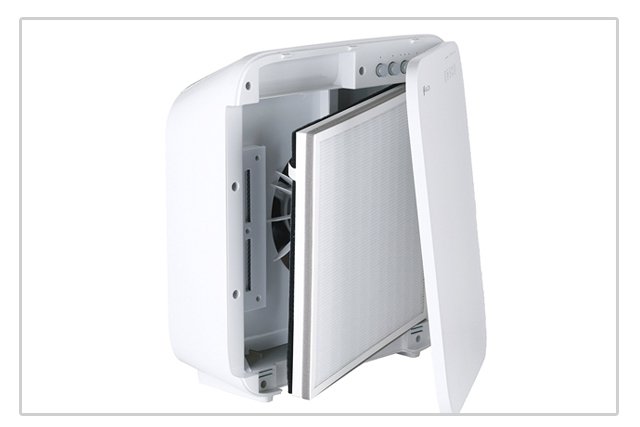Air purifiers have been a rising trend for a few years now. Perhaps it is because of the increasing air pollution in cities and industrial zones. Or it is because of the growing number of viruses and diseases globally. Whatever reason it may be, it always comes down to “Do air purifiers work?”
A short answer to that is yes! However, we’ll dive deeper into details later on in the article to justify our claim.
Moreover, a US Environmental Protection Agency report suggests that indoor air can be five times more polluted than outdoor air. And since an average person spends over 90% of his time indoors, it really is a cause for concern.
[toc]What Is an Air Purifier/What Does an Air Purifier Do?

As the name suggests, the basic function of a whole-house air purifier is to clean the air. But it does so through various methods. The purification methods are divided into two main categories: active and passive air purification.
Some air purifiers release negatively charged ions into the air to neutralize the positive ions (allergens & toxins). These neutralized particles then stick to surfaces, i.e., ceilings, walls, carpets, furniture, etc. This is known as the Active Air Purification method.
Passive air purifiers are by far the most effective and recommended types of air purifiers. They feature a filter or a set of filters to trap the airborne particles. You can clean these filters and permanently remove the toxins and allergens from an indoor environment.
House air purifiers work opposite to aroma diffusers and humidifiers. Where they release extra particles to the air, purifiers trap particles and ensure you breathe clean air.
Utilizing the latest tech inventions introduces comfort to your living. Air purifiers are an excellent example of such innovations that bring you as close to nature as possible.
Do Air Purifiers Work?

Air filtration systems are definitely worth it if you’re allergic to airborne pollutants like toxins, allergens, mold, pet dander, etc. But even if you don’t have a prominent allergy or a health condition, they may still add a few healthy years to your life.
However, you must know that an air purifier doesn’t rid your house/room of all unwanted particles. Because some particles tend to stick on surfaces, you may still need to clean and sanitize your house regularly.
Typically, air purifiers work best when coupled with other cleaning methods. For example, with an air filter, vacuuming, etc. Do air purifiers work or not is better explained by how they rid the indoor air of your house from the following aggravating particles:
1. Indoor Toxins
Carbon Monoxide (CO), Nitrogen Dioxide (NO2), Radon, and Secondhand Smoke are the major toxins found in your house. Especially if you live near a busy road or in a populated city.
These toxins are the greatest contributors to long-term health conditions as Alzheimer’s and Dementia. You cannot detect these toxins as they are colorless and odorless, but excessive exposure can potentially be harmful.
Moreover, cleaning agents and personal care products also emit these toxins into the air. Although an air purifier proves effective against these particles, your best bet is to limit their use in the first place.
2. Mold and Mildew
Mold is probably the most common household parasite we have across the US. It thrives in humid conditions and grows rapidly. Also, mold is infamous for releasing airborne particles that trigger allergies and other health conditions.
Mold spores are kryptonite for people with asthma or suffering from other respiratory illnesses.
Although the best air purifier for mold may clean most airborne mold spores in the air, you need to dehumidify your house to cut off the problem completely.
3. Allergens
Allergens are antigens that trigger a vigorous immune response and cause an allergic reaction – Source.
Dust mites, pollen, and pet dander are the most common allergens. However, a person can be allergic to anything from peanuts to poison ivy.
Allergens cause an allergic reaction when ingested or inhaled. And to prevent the latter, air purifiers for allergies with high-efficiency particulate arresting (HEPA) work best. They have a series of filters that are known best for their allergen-trapping capacity.
4. Smoke
You get smoke in your house from three major sources: cooking in the kitchen, smoking indoors, and landscape smoke. While the smoke’s smell is irritating and upsetting, it is harmful, too, as it has unburnt compounds.
According to research, air purifiers reduce smoke particles indoors, but there is little difference in nicotine content.
So, a purifier cannot be an alternative to smoking cessation. While you may reduce the quantity, smoking indoors may still prove harmful for infants and pregnant women.
Air Purifier Benefits:

Air purifiers that feature HEPA technology filters can reduce the particulate matter in the air by 99.97%. If you’re wondering what an air purifier does, the following benefits may give you a better picture:
1. Reduces the Spread of Viruses and Bacteria
Viruses and bacteria are tiny pathogens that are most likely to be airborne. You can validate that by how a single person infected with a cold or flu spreads it to the entire family. That’s because everyone breathing in the same air as an infected person catches the disease.
An air purifier (especially with a HEPA filter) traps most of these viruses and bacteria. And as a result, you reduce the chances of being infected by airborne diseases.
2. Relieves Asthmatic Symptoms
Asthma is a common respiratory condition that affects every 1 in 12 people and costs US $56 billion in medical costs, early deaths, and lost school and workdays.
Pollutants in the air, such as mold, pet dander, pollen, and dust, irritate asthmatic people’s airways. And with already inflamed bronchial tubes, it gets difficult to breathe.
Air purification systems are a strong recommendation for people with asthma or other respiratory conditions. Since they so effectively alleviate asthmatic symptoms, air purifiers can make your life more comfortable indoors.
3. Improves Sleep Quality
Allergens in the air not only trigger allergies and make it harder to breathe for people with respiratory conditions, but they also deeply affect your sleep quality.
A common cause of sleep disturbances is a congested or runny nose. And it happens mostly because of airborne diseases like hay fever.
An air purifier in your house can help prevent the spread of such a disease in the first place. Plus, cleaner indoor air is less likely to give you nasal congestion. Hence improving your sleep quality.
4. Gets Rid of Harmful Chemicals
Many outdoor pollutants come with risks of diseases like cancer, tumors, and neurological disorders. Carbon Monoxide and Nitrogen Dioxide are the leading ones, commonly found in large cities or places with traffic.
While opening your windows and doors to let the air circulate is one way of doing things, it is not so effective. You need to have an air purifier for dust and chemicals to ensure you get clean air to breathe in.
5. Reduces Odors
Odors are not only unpleasant, but they cripple your productivity and performance. Compounds like Benzene break apart at room temps and give off an unpleasant odor. Not only that, the odors from cooking in the kitchen or a clogged washroom can be as annoying.
But an air purifier helps cover that up as well. So, no running around to ventilate your entire; an air purifier eliminates all unpleasant smells and odors.
Types Of Air Purifier:
For an appliance so talked about, it comes as no surprise that it has many variants. While all air purifiers have the same feature of cleaning the air in your house, some models are better equipped for specific functions like clearing smoke, preventing allergies, or improving sleep.
1. Ozone Air Purifiers

These purifiers work by releasing Ozone gas (O3) into the air to react with indoor pollutants. Since most indoor pollutants are unreactive or take ages to react with ozone, these purifiers also feature a negative ion method.
However, health experts do not recommend the use of these purifiers as they can worsen health conditions. In extreme cases, excessive exposure to Ozone gas can scar the lungs of an asthmatic person.
2. Negative Ion Air Purifiers

The negative ion air purifiers are more commonly used appliances. They work by the basic principles of ionization, where two charged particles attract each other.
The purifier releases a burst of negative ions (Oxygen with an electron) into the air. These negatively charged ions attract pollutants, making a heavy particle fall to the ground. You must then clean the surfaces to rid your house of these pollutants completely.
3. Activated Carbon Technology

These air purifiers have a sheet of activated carbon to trap large pollutant particles in the air. Carbon is processed for a larger surface area, and porous properties make activated carbon technology.
Since the major concern for cleaning the air is to get rid of pet dander, mold, allergens, and dust, these purifiers fit in quite nicely. Because of their porous texture, they trap pollutants and do not allow recontamination.
4. High-Efficiency Particulate Air (HEPA)

HEPA technology air purifiers are the most durable and liked appliances on the market. They are ideal for removing large pollutant particles through a maze-like structure of the filter.
HEPA filters clean the air of your house through interception, impaction, and diffusion. To eliminate odors and other chemical pollutants in the air, HEPA filters usually feature an activated carbon filter to help clean the air more effectively.
5. UV Technology

Air purifiers that feature UV technology are the best for killing viruses, bacteria, germs, and other microorganisms.
These purifiers have a UV lamp to which the air is directed through a fan. The UV lamp causes cellular or genetic damage to the air’s microorganisms, making them completely harmless.
However, a UV technology air purifier is usually coupled with HEPA to filter out the large pollutant particles.
Ending Thoughts:
By making it to the end of the article, what’s your verdict? Do air purifiers work, and are they worth it?
The benefits of air purifiers offer much value for the cost you get them. However, relying completely on an air purifier to clean an indoor environment is not nearly enough. To ensure a clean indoor environment, you must adopt other active cleaning methods, such as wiping surfaces.
And now that we face the unprecedented threats of airborne viruses and extreme smog, air purifiers are the only answer to a healthy and sustained living. That said, we hope the above piece covered all of your worries, and now you’re better equipped to choose an air purifier for your home.





